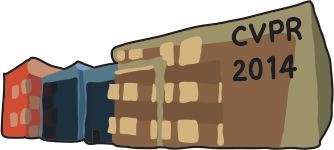-
Better Feature Tracking Through Subspace Constraints
AbstractFeature tracking in video is a crucial task in computer vision. Usually, the tracking problem is handled one feature at a time, using a single-feature tracker like the Kanade-Lucas-Tomasi algorithm, or one of its derivatives. While this approach works quite well when dealing with high-quality video and "strong" features, it often falters when faced with dark and noisy video containing low-quality features. We present a framework for jointly tracking a set of features, which enables sharing information between the different features in the scene. We show that our method can be employed to track features for both rigid and non-rigid motions (possibly of few moving bodies) even when some features are occluded. Furthermore, it can be used to significantly improve tracking results in poorly-lit scenes (where there is a mix of good and bad features). Our approach does not require direct modeling of the structure or the motion of the scene, and runs in real time on a single CPU core.
Related Material
[pdf][bibtex]@InProceedings{Poling_2014_CVPR,
author = {Poling, Bryan and Lerman, Gilad and Szlam, Arthur},
title = {Better Feature Tracking Through Subspace Constraints},
booktitle = {Proceedings of the IEEE Conference on Computer Vision and Pattern Recognition (CVPR)},
month = {June},
year = {2014}
}
These CVPR 2014 papers are the Open Access versions, provided by the Computer Vision Foundation.
Except for the watermark, they are identical to the accepted versions; the final published version of the proceedings is available on IEEE Xplore.
Except for the watermark, they are identical to the accepted versions; the final published version of the proceedings is available on IEEE Xplore.
This material is presented to ensure timely dissemination of scholarly and technical work.
Copyright and all rights therein are retained by authors or by other copyright holders.
All persons copying this information are expected to adhere to the terms and constraints invoked by each author's copyright.

